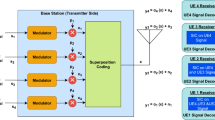Abstract
Overloading is a technique to accommodate more number of users than the spreading factor N. This is an efficient way to increase the number of users in a fixed bandwidth, which is of practical interest to mobile system operators. In this paper we have reviewed the different overloading schemes proposed in the literature for the DS-CDMA systems. The performance of an Orthogonal/Orthogonal (O/O) overloading scheme, using two sets of orthogonal codes (O/s-O) has been evaluated. Iterative multistage detector (IMSD) is used to reduce the multiple access interference between the users of two sets. The BER performance of IMSD is evaluated with hard and soft decisions functions using Monte-Carlo simulations. It is found that, this scheme provides 19% and 11% channel overloading for synchronous DS-CDMA system in an AWGN channel, with a SNR degradation of less than 0.5 dB at a BER of 10− 5 compared to single user bound for N=16 and 64 respectively.
Preview
Unable to display preview. Download preview PDF.
Similar content being viewed by others
References
Adachi, F., Sawahashi, M., Suda, H.: Wideband DS-CDMA for Next- Generation Mobile Communication Systems. IEEE Commun. Mag. 36, 56–59 (1998)
Hara, S., Prasad, R.: Overview of multicarrier CDMA. IEEE Commun. Mag. 35, 126–133 (1997)
Verdu, S.: Multi - user Detection. Cambridge University Press, Cambridge (1998)
Verdu, S., Shamai, S.: Spectral Efficiency of CDMA with Random Spreading. IEEE Trans. Inform. Theory. 55, 622–640 (1999)
Viswanath, P., Anantharam, V.: Optimal Sequences and Sum Capacity of Synchronous CDMA Systems. IEEE Trans. Inform. Theory. 45, 1984–1991 (1999)
Ulukus, S., Yates, R.D.: Iterative Construction of Optimum Signature Sequence Sets in Synchronous CDMA Systems. IEEE Trans. Inform. Theory 47, 1989–1998 (2001)
Learned, R.E., Willisky, A.S., Boroson, D.M.: Low complexity joint detection for oversaturated multiple access communications. IEEE Trans. Signal Processing 45, 113–122 (1997)
Ross, J.A.F., Taylor, D.P.: Multiuser Signaling in the Symbol- Synchronous AWGN Channel. IEEE Trans. Inform. Theory 41, 1174–1178 (1995)
Sari, H., Vanhaverbeke, F., Moeneclaey, M.: Extending the Capacity of Multiple Access Channels. IEEE Commun. Mag. 38, 74–82 (2000)
Sari, H., Vanhaverbeke, F., Moeneclaey, M.: Increasing the Capacity of CDMA using Hybrid Spreading Sequences and Iterative Multistage Detection. In: Proc. IEEE VTC, pp. 1160–1164 (1999)
Vanhaverbeke, F., Moeneclaey, M., Sari, H.: DS/CDMA with Two Sets of Orthogonal Sequences and Iterative - Detection. IEEE Commun. Lett. 4, 289–291 (2000)
Sari, H., Vanhaverbeke, F., Moeneclaey, M.: Multiple access using two sets of orthogonal signal waveforms. IEEE Commun. Lett. 4, 4–6 (2000)
Kumar, P., Chakrabarti, S.: A New Overloading Scheme for DS- CDMA System. In: National Conference on Communication, IIT Kanpur, pp. 285–288 (2007)
Djonin, D., Bhargava, V.K.: New results on low complexity detectors for oversaturated CDMA systems. In: Proceedings of Globecom 2001, pp. 846–850 (2001)
Paavola, J., Ipatov, V.: Oversaturating Synchronous CDMA Systems on the Signature Per User Basis. In: Proc. 5th European Personal Mobile Communications Conf., pp. 427–430 (2003)
Yang, K., Kim, Y.K., Kumar, P.V.: Quasi-orthogonal Sequences for Code-division Multiple-Access Systems. lEEE Trans. Inform. Theory. 46, 982–993 (2000)
Vanhaverbeke, F., Moeneclaey, M.: Binary signature sets for increased user capacity on the downlink of a CDMA systems. IEEE Trans. on Wireless Communication 05, 1795–1804 (2006)
Vanhaverbeke, F., Moeneclaey, M.: Performance Evaluation of Three Different Types of Channel overloading. In: IEEE PIMRC, pp. 569–572 (2003)
Author information
Authors and Affiliations
Editor information
Rights and permissions
Copyright information
© 2007 Springer-Verlag Berlin Heidelberg
About this paper
Cite this paper
Kumar, P., Ramesh, M., Chakrabarti, S. (2007). Overloading Cellular DS-CDMA: A Bandwidth-Efficient Scheme for Capacity Enhancement. In: Rao, S., Chatterjee, M., Jayanti, P., Murthy, C.S.R., Saha, S.K. (eds) Distributed Computing and Networking. ICDCN 2008. Lecture Notes in Computer Science, vol 4904. Springer, Berlin, Heidelberg. https://doi.org/10.1007/978-3-540-77444-0_55
Download citation
DOI: https://doi.org/10.1007/978-3-540-77444-0_55
Publisher Name: Springer, Berlin, Heidelberg
Print ISBN: 978-3-540-77443-3
Online ISBN: 978-3-540-77444-0
eBook Packages: Computer ScienceComputer Science (R0)




